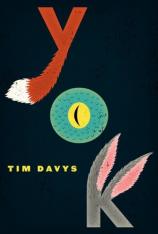Yok
Review
Yok
This year is the 200th anniversary of CHILDREN’S AND HOUSEHOLD TALES, the first collection of folk tales by the Brothers Grimm. As anyone who has read them knows, these stories, though ostensibly for young people, are dark and often violent. In “The Wolf and the Seven Young Kids,” a mother goat discovers upon returning from a search for food that a wolf has eaten six of her seven children. When she finds the bloated wolf lying under a tree, she cuts open the wolf’s belly with a pair of scissors, rescues her children, fills the belly with rocks, and sews the wolf back up. The wolf then drowns when he sinks to the bottom of a river. Most of the other tales are similarly light-hearted.
"One assumes that the use of stuffed animals as stand-ins for humans was meant to heighten the novel’s moral and philosophical issues, just as in folk tales. And, like folk tales, YOK is an inventive piece of literature. There are many clever details."
I thought of these stories as I read YOK, the fourth novel by Tim Davys about the fictional Mollisan Town. (I haven’t read the other three.) According to HarperCollins’s website, Tim Davys is a pseudonym for “a well-known Swedish public figure.” It’s not surprising, then, that, like most recent Swedish fiction, YOK --- the title is the name of a less than desirable neighborhood --- is gritty and relentlessly bleak. Dreams are shattered. Characters are tortured. Just when you think a protagonist will find happiness, a cruel Nordic twist whisks him to despair.
The gimmick of these four unrelated stories is that the characters are all stuffed animals. They dress and talk just as humans would, but every one of them is a child’s toy. This and the dark subject matter are what give the book its folk-tale quality. Although the publisher isn’t marketing it as such, YOK is closer to young adult fiction, with its themes of alienation and existential dread, than to literary fiction.
Each story’s protagonist is young and faces a dilemma. In the first story, Antonio Ortega Fox, a male model who is considering a film career, falls in love with Beatrice Cockatoo, the daughter of underworld boss Dragon Aguado Molina. The Dragon says he will allow the young people to marry if Fox brings him a feather, an arm and a heart. In the second story, Erik Gecko, a low-level brewery employee, has two older brothers who vie to become television presenters for a local morning show. The gecko must deal with his brothers’ competing jealousies while also wondering whether he, too, should pursue a dream that will help him escape his life of drudgery.
The third protagonist is Mike Chimpanzee, a rock guitarist who lives in an antique shop and has trouble thinking up lyrics for the song he hopes will resuscitate his once-promising career. When he idly picks up a blue bottle while trying to compose, a genie comes out and offers him three wishes. But except for a month’s supply of marijuana, he can’t think of anything he really wants. Indecision of a different sort afflicts Vincent Hare in the final story. Vincent is a talented artist who also has an aptitude in architecture. His difficulty in reconciling the age-old conflict of art versus commerce leads him to questions of free will and the purpose of existence, and precipitates a bout of depression that has crippling consequences.
Perhaps you have gathered by now that YOK is an odd reading experience. One assumes that the use of stuffed animals as stand-ins for humans was meant to heighten the novel’s moral and philosophical issues, just as in folk tales. And, like folk tales, YOK is an inventive piece of literature. There are many clever details. Streets are different colors, from mint green East Avenue to saffron yellow Puerta de Alcalà. Fox tells the Dragon that he has come to ask for his daughter’s claw. Everyone with a car drives a Volga --- a joke, one assumes, on the ubiquity of Volvos in Sweden.
And yet the book as a whole is only intermittently successful. The Fox and Chimpanzee stories are the best and most memorable. They are entertaining, making their points gracefully and as part of the narrative. However, the Gecko and Hare stories get bogged down in philosophical observations. Whimsy and existential angst can be strange bedfellows. In this novel, the combination works in some cases but not in others. As the wolf in the Grimm story discovered, a feast isn’t necessarily as succulent as it seems.
Reviewed by Michael Magras on August 10, 2012
Yok
- Publication Date: July 31, 2012
- Genres: Fiction
- Hardcover: 368 pages
- Publisher: Harper
- ISBN-10: 0061797472
- ISBN-13: 9780061797477




